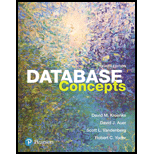
Database Concepts (8th Edition)
8th Edition
ISBN: 9780134601533
Author: David M. Kroenke, David J. Auer, Scott L. Vandenberg, Robert C. Yoder
Publisher: PEARSON
expand_more
expand_more
format_list_bulleted
Textbook Question
thumb_up100%
Chapter 1, Problem 1.6RQ
Describe the purpose of a
Expert Solution & Answer
Want to see the full answer?
Check out a sample textbook solution
Students have asked these similar questions
How can I perform Laplace Transformation when using integration based on this?
Write an example of a personal reflection of your course.
- What you liked about the course.
- What you didn’t like about the course.
- Suggestions for improvement.
Course: Information and Decision Sciences (IDS)
The Reflection Paper should be 1 or 2 pages in length.
How can I perform Laplace Transformation when using integration ?
Chapter 1 Solutions
Database Concepts (8th Edition)
Ch. 1 - Prob. 1.1RQCh. 1 - Prob. 1.2RQCh. 1 - Prob. 1.3RQCh. 1 - Why is the study of database technology important?Ch. 1 - Prob. 1.5RQCh. 1 - Describe the purpose of a database.Ch. 1 - Prob. 1.7RQCh. 1 - Prob. 1.8RQCh. 1 - Prob. 1.9RQCh. 1 - Prob. 1.10RQ
Ch. 1 - Break the list in Figure 1-34 into two tables,...Ch. 1 - Show how the tables you created for question 1.11...Ch. 1 - Prob. 1.13RQCh. 1 - Prob. 1.14RQCh. 1 - Break the list in Figure 1-35 into tables, each...Ch. 1 - Describe in your own words and illustrate with...Ch. 1 - Prob. 1.18RQCh. 1 - Define the term database.Ch. 1 - Prob. 1.20RQCh. 1 - List the components of a database.Ch. 1 - Prob. 1.22RQCh. 1 - Prob. 1.23RQCh. 1 - Prob. 1.24RQCh. 1 - What is the purpose of a DBMS?Ch. 1 - List the specific functions of a DBMS.Ch. 1 - Define the term referential integrity constraint....Ch. 1 - Prob. 1.28RQCh. 1 - List the functions of a database application.Ch. 1 - Prob. 1.30RQCh. 1 - Prob. 1.31RQCh. 1 - Prob. 1.32RQCh. 1 - Prob. 1.33RQCh. 1 - Prob. 1.34RQCh. 1 - Prob. 1.35RQCh. 1 - Prob. 1.36RQCh. 1 - Prob. 1.37ECh. 1 - Prob. 1.38ECh. 1 - Prob. 1.39E
Additional Engineering Textbook Solutions
Find more solutions based on key concepts
What is a user interface?
Starting Out with Python (4th Edition)
This optional Google account security feature sends you a message with a code that you must enter, in addition ...
SURVEY OF OPERATING SYSTEMS
Assume a class named Numbers has the following static member function declaration: static void showTotal(); Wri...
Starting Out with C++ from Control Structures to Objects (9th Edition)
Gas Prices In the student sample program files for this chapter, you will find a text file named GasPrices.txt....
Starting Out with Java: From Control Structures through Data Structures (4th Edition) (What's New in Computer Science)
In Exercises 39 through 44, write a program to carry out the stated task. Cost of Electricity The cost of the e...
Introduction To Programming Using Visual Basic (11th Edition)
What will be the final value of dblResult in the following sequence? Dim dblResult As Double = 3.5 dblResult = ...
Starting Out With Visual Basic (8th Edition)
Knowledge Booster
Learn more about
Need a deep-dive on the concept behind this application? Look no further. Learn more about this topic, computer-science and related others by exploring similar questions and additional content below.Similar questions
- I need help in explaining how I can demonstrate how the Laplace & Inverse transformations behaves in MATLAB transformation (ex: LIke in graph or something else)arrow_forwardYou have made the Web solution with Node.js. please let me know what problems and benefits I would experience while making the Web solution here, as compared to any other Web solution you have developed in the past. what problems and benefits/things to keep in mind as someone just learningarrow_forwardPHP is the server-side scripting language. MySQL is used with PHP to store all the data. EXPLAIN in details how to install and run the PHP/MySQL on your computer. List the issues and challenges I may encounter while making this set-up? why I asked: I currently have issues logging into http://localhost/phpmyadmin/ and I tried using the command prompt in administrator to reset the password but I got the error LOCALHOST PORT not found.arrow_forward
arrow_back_ios
SEE MORE QUESTIONS
arrow_forward_ios
Recommended textbooks for you
 Enhanced Discovering Computers 2017 (Shelly Cashm...Computer ScienceISBN:9781305657458Author:Misty E. Vermaat, Susan L. Sebok, Steven M. Freund, Mark Frydenberg, Jennifer T. CampbellPublisher:Cengage Learning
Enhanced Discovering Computers 2017 (Shelly Cashm...Computer ScienceISBN:9781305657458Author:Misty E. Vermaat, Susan L. Sebok, Steven M. Freund, Mark Frydenberg, Jennifer T. CampbellPublisher:Cengage Learning Fundamentals of Information SystemsComputer ScienceISBN:9781337097536Author:Ralph Stair, George ReynoldsPublisher:Cengage Learning
Fundamentals of Information SystemsComputer ScienceISBN:9781337097536Author:Ralph Stair, George ReynoldsPublisher:Cengage Learning- COMPREHENSIVE MICROSOFT OFFICE 365 EXCEComputer ScienceISBN:9780357392676Author:FREUND, StevenPublisher:CENGAGE LNp Ms Office 365/Excel 2016 I NtermedComputer ScienceISBN:9781337508841Author:CareyPublisher:Cengage
 Programming with Microsoft Visual Basic 2017Computer ScienceISBN:9781337102124Author:Diane ZakPublisher:Cengage Learning
Programming with Microsoft Visual Basic 2017Computer ScienceISBN:9781337102124Author:Diane ZakPublisher:Cengage Learning

Enhanced Discovering Computers 2017 (Shelly Cashm...
Computer Science
ISBN:9781305657458
Author:Misty E. Vermaat, Susan L. Sebok, Steven M. Freund, Mark Frydenberg, Jennifer T. Campbell
Publisher:Cengage Learning

Fundamentals of Information Systems
Computer Science
ISBN:9781337097536
Author:Ralph Stair, George Reynolds
Publisher:Cengage Learning


COMPREHENSIVE MICROSOFT OFFICE 365 EXCE
Computer Science
ISBN:9780357392676
Author:FREUND, Steven
Publisher:CENGAGE L

Np Ms Office 365/Excel 2016 I Ntermed
Computer Science
ISBN:9781337508841
Author:Carey
Publisher:Cengage

Programming with Microsoft Visual Basic 2017
Computer Science
ISBN:9781337102124
Author:Diane Zak
Publisher:Cengage Learning
How to Design DB Tables for any Application? (The Basics); Author: Studytonight;https://www.youtube.com/watch?v=XUdNVaSikqY;License: Standard YouTube License, CC-BY
Create a Table (Introduction to Oracle SQL); Author: Database Star;https://www.youtube.com/watch?v=BiV1IrzB1sY;License: Standard Youtube License